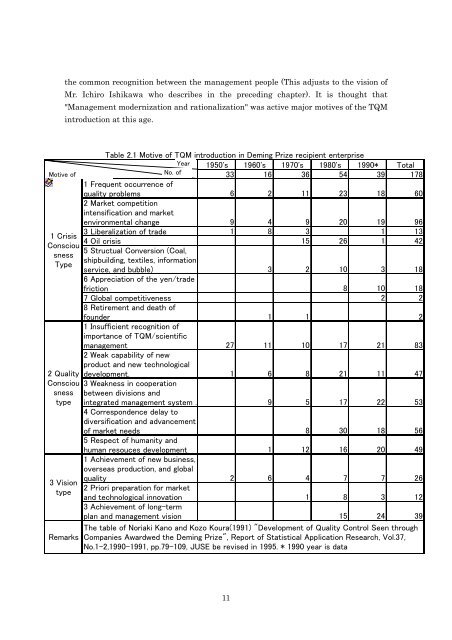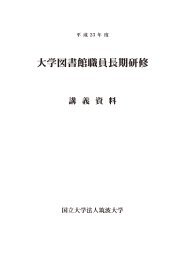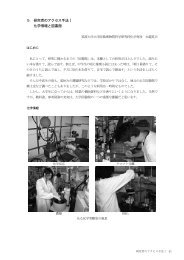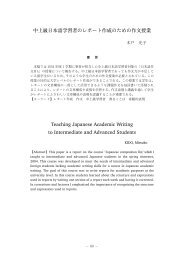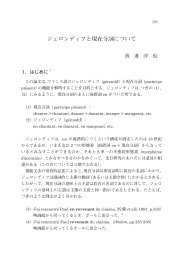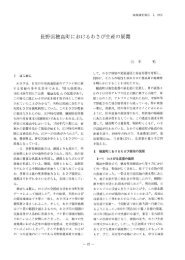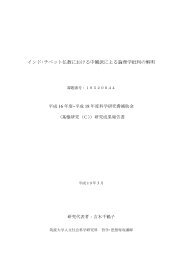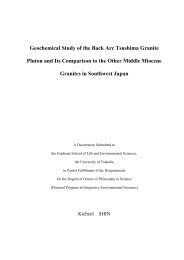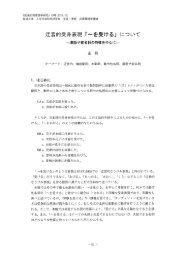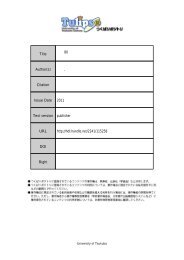- Page 1 and 2: TQM Model of Elements-Deployment Ta
- Page 3 and 4: 3.4 Foundation of Japan Quality Awa
- Page 5 and 6: 8.4.2 Fundamental Concept 227 8.4.3
- Page 7 and 8: Figure 4.4 View Points of examinati
- Page 9 and 10: Table 2.13 Education Courses of gro
- Page 11 and 12: Table 8.5 Execution Rate of each Fu
- Page 13 and 14: global competitiveness and manageme
- Page 15 and 16: is called the Process Control Empha
- Page 17 and 18: started in the same year in 1987 to
- Page 19 and 20: Chapter 2 Deming Prize and its Infl
- Page 21: overseas companies and except 15 JQ
- Page 25 and 26: Purpose of promotion 1 Managem ent
- Page 27 and 28: method of promotion, and all compan
- Page 29 and 30: A new product and new technological
- Page 31 and 32: Table 2.5 Criteria for Tangible Eff
- Page 33 and 34: Table 2.6 Intangible Effects of TQM
- Page 35 and 36: It is actually feeling of all emplo
- Page 37 and 38: In addition, there is an company gr
- Page 39 and 40: Contributing to the quality improve
- Page 41 and 42: Management Theory and the IE introd
- Page 43 and 44: . 2.5.2 Social Influence of Groups-
- Page 45 and 46: As shown in Table 2.9, Toyota Group
- Page 47 and 48: Table 2.10 Main Quality Awards that
- Page 49 and 50: education outside the company, and
- Page 51 and 52: Table 2.13 Educational Course of gr
- Page 53 and 54: (G) Company Evaluation System (1) Q
- Page 55 and 56: ③ Proceed to organize TQM promoti
- Page 57 and 58: Grancing over such status report, w
- Page 59 and 60: And, there is part delivery manufac
- Page 61 and 62: planning stage, and be opened the d
- Page 63 and 64: the Antitrust Law of the USA, but t
- Page 65 and 66: These social systems were planned a
- Page 67 and 68: concept dessemination and rearing Q
- Page 69 and 70: Reference 1. Noriaki Kano and Kozo
- Page 71 and 72: 36. J.M. Juran: Up-coming century o
- Page 73 and 74:
and individual visited to JUSE from
- Page 75 and 76:
EQA propagated to all Europe and Af
- Page 77 and 78:
Middle East, and Asian countries. M
- Page 79 and 80:
management-led and customer-oriente
- Page 81 and 82:
September 15, 1988, and the quality
- Page 83 and 84:
Then, EU (European Union) and EFTA
- Page 85 and 86:
No. of Companies 120 100 80 60 40 2
- Page 87 and 88:
This observation was further mentin
- Page 89 and 90:
further than we could have done on
- Page 91 and 92:
for business result/performance eva
- Page 93 and 94:
(C) Social influence of Malcolm Bal
- Page 95 and 96:
Sum of Winners 70 60 50 40 30 20 10
- Page 97 and 98:
④ Create a succinct decription of
- Page 99 and 100:
Award was won at the international
- Page 101 and 102:
The social influence of JQA is summ
- Page 103 and 104:
the TQM activities is concentrated
- Page 105 and 106:
Reference 1. Noriaki, Kano and Kozo
- Page 107 and 108:
Chapter 4 Development of Comparison
- Page 109 and 110:
Award TQM Element Deployment Table
- Page 111 and 112:
(2) MBNQA is recognized their requi
- Page 113 and 114:
Table, 4.1 Emphasis point % compari
- Page 115 and 116:
method. This system are structured
- Page 117 and 118:
The EQA was further expanded the co
- Page 119 and 120:
(C) Objectives (1) Exept Deming Pri
- Page 121 and 122:
1 Leadership (120) Leader ship (10%
- Page 123 and 124:
Aim of TQM Framework of TQM (10) Co
- Page 125 and 126:
(b) Item for Human Resource related
- Page 127 and 128:
Table 4.4 Comparison of Expensecost
- Page 129 and 130:
(3) The assessment process is that
- Page 131 and 132:
Functional analysis of Deming Prize
- Page 133 and 134:
Step 2 to Step 3 Conversion of 4 th
- Page 135 and 136:
(Deming Prize Committee [7]), “Ma
- Page 137 and 138:
of MBNQA by Table 4.8 decrease elem
- Page 139 and 140:
Table 4.12 TQM Elements Deployment
- Page 141 and 142:
that this matrix is organized by 18
- Page 143 and 144:
Table 4.13 is named "TQM Elements D
- Page 145 and 146:
anking is done, rough of the featur
- Page 147 and 148:
There is neither "3 Customers and M
- Page 149 and 150:
Comparing the both, it is shown tha
- Page 151 and 152:
ut the coparison possibility can be
- Page 153 and 154:
5. EFQM: The EFQM Excellence Model
- Page 155 and 156:
Attached Table: TQM Quality Award E
- Page 157 and 158:
y mutual comparison of each Quality
- Page 159 and 160:
In the Principal Component Analysis
- Page 161 and 162:
correlation with element related to
- Page 163 and 164:
Quality Award, as shown in Fig. 5.1
- Page 165 and 166:
About the absolute value of Factor
- Page 167 and 168:
Fundamental Feature (Speciality) To
- Page 169 and 170:
the Basis of quality management is
- Page 171 and 172:
Table 5.5 Summary of Factor Structu
- Page 173 and 174:
Table 5.6 Common factor and Factor
- Page 175 and 176:
technology utilization, To develop
- Page 177 and 178:
Reference 1. Kozo Koura, Tadashi Yo
- Page 179 and 180:
1 Partner factor 6 Customer Market
- Page 181 and 182:
Criteria Element into each crossing
- Page 183 and 184:
Table 6.1 MBNQA Criteria Item Ttime
- Page 185 and 186:
It is summarized that the criteria
- Page 187 and 188:
Table 6.3 Contribution Ratio of Eig
- Page 189 and 190:
|Factor Loading| ≧ 0.4 or less: L
- Page 191 and 192:
esults |Factor Loading| ≧ 0.4 or
- Page 193 and 194:
(f) criteria in 2003 About the abso
- Page 195 and 196:
2001 (former) Table 6.4 Summary of
- Page 197 and 198:
2001 former), “Meassurement, anal
- Page 199 and 200:
Fiscal Year 1988 1989 1997 1999 200
- Page 201 and 202:
management" for the future and "Qua
- Page 203 and 204:
Table 7.1 Progress of Management an
- Page 205 and 206:
Cost-up. The Construction of Consti
- Page 207 and 208:
improving steadily by promoting dep
- Page 209 and 210:
It was decided to achieve the above
- Page 211 and 212:
TQM (illustration)" as a common sta
- Page 213 and 214:
Because TQM is company-wide activit
- Page 215 and 216:
information management (IT; informa
- Page 217 and 218:
Fig. 7.3 The Evolution of Strategic
- Page 219 and 220:
7.4 Management at which TQM aims Wh
- Page 221 and 222:
Management for Policy: Development
- Page 223 and 224:
When settling on by 2005 visions, A
- Page 225 and 226:
Chapter 8 Cross-Functional Manageme
- Page 227 and 228:
Cross-Functional Management being c
- Page 229 and 230:
The left side of Fig. 8.1 is Deming
- Page 231 and 232:
cross-functionaly with TQM by board
- Page 233 and 234:
For example, a Worjing Team of Qual
- Page 235 and 236:
Fig.8.5 (a) Highly Developed Organi
- Page 237 and 238:
8.3.2 Role and Duty of Cross-Functi
- Page 239 and 240:
(1) All mutual agreement is obtaine
- Page 241 and 242:
It is understood that the compositi
- Page 243 and 244:
And, if it is company-wide problem,
- Page 245 and 246:
department become secretariat thoug
- Page 247 and 248:
(3) Do not think that Division Mana
- Page 249 and 250:
is clarified though the business jo
- Page 251 and 252:
After 1960's, most of the Deming Pr
- Page 253 and 254:
Management (10.5) Auxiliary functio
- Page 255 and 256:
Table 8.7 Problems before Introduct
- Page 257 and 258:
Table 8.9 Main Problem before Intro
- Page 259 and 260:
Table 8.10 Effects after Introducti
- Page 261 and 262:
(4) It becomes easy for the Bottom
- Page 263 and 264:
Reference 1. Kozo Koura: Developmen
- Page 265 and 266:
September 1999 32. Michiteru Ono: J
- Page 267 and 268:
Table 9.1 Summary of Comarison Anal
- Page 269 and 270:
(a) Processes that benefit customer
- Page 271 and 272:
That is, ISO proposed the process f
- Page 273 and 274:
Table 9.2 Comparison of Leaderships
- Page 275 and 276:
of joint collaboration work beween
- Page 277 and 278:
It was President TQM Diagnosis in D
- Page 279 and 280:
classes are sent with at the top th
- Page 281 and 282:
His interest never waned. If the mo
- Page 283 and 284:
preparation processing in a new age
- Page 285 and 286:
William A. Golomski cooperated behi
- Page 287 and 288:
And, this relates to the civilizati
- Page 289 and 290:
Reference 1. Masao Nemoto, Kozo Kou
- Page 291:
for receiving the material offer fr


